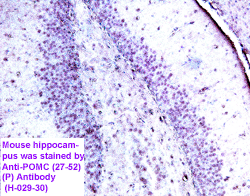Catalog # |
Size |
Price |
|
|---|---|---|---|
| H-029-30 | 50 µl | $225 |
|
| Rabbit |
|
| Polyclonal |
| View/Download (PDF) - for reference only | |
|
| Reconstitute with 50 µl of distilled water for the equivalent of undiluted antiserum. |
|
| Please store the lyophilized antibody at -20°C upon receipt for up to 24 months. For optimal results, use the antibody immediately after reconstitution. Once reconstituted, the antibody is stable for up to three (3) days at 4°C. For longer-term storage up to three (3) months, prepare small aliquots of the reconstituted antibody and freeze at -20°C or -80°C. Repeated freeze-thaw cycles should be strictly avoided. |
|
| Each vial contains 50 µl of lyophilized rabbit antiserum. |
|
| View/Download(PDF) |

Cerebral cell renewal in adult mice controls the onset of obesity.
Gouazé A, Brenachot X, Rigault C, et al. PLoS ONE. 2013;8(8):e72029.
Evidence that orphanin FQ mediates progesterone negative feedback in the ewe.
Nestor CC, Coolen LM, Nesselrod GL, et al. Endocrinology. 2013;154(11):4249-58.
Information processing in brainstem bitter taste-relaying neurons defined by genetic tracing.
Sugita M, Yamamoto K, Hirono C, Shiba Y. Neuroscience. 2013;250:166-80.
Activation of melanocortin receptors in the intermediolateral cell column of the upper thoracic cord elicits tachycardia in the rat.
Iwasa M, Kawabe K, Sapru HN. Am J Physiol Heart Circ Physiol. 2013;305(6):H885-93.
Distinct glutamatergic and GABAergic subsets of hypothalamic pro-opiomelanocortin neurons revealed by in situ hybridization in male rats and mice.
Wittmann G, Hrabovszky E, Lechan RM. J Comp Neurol. 2013;521(14):3287-302.
Aminoprocalcitonin-mediated suppression of feeding involves the hypothalamic melanocortin system.
Tavares E, Maldonado R, Miñano FJ. Am J Physiol Endocrinol Metab. 2013;304(12):E1251-62.
Acute and long-term suppression of feeding behavior by POMC neurons in the brainstem and hypothalamus, respectively.
Zhan C, Zhou J, Feng Q, et al. J Neurosci. 2013;33(8):3624-32.
Refeeding-activated glutamatergic neurons in the hypothalamic paraventricular nucleus (PVN) mediate effects of melanocortin signaling in the nucleus tractus solitarius (NTS).
Singru PS, Wittmann G, Farkas E, Zséli G, Fekete C, Lechan RM. Endocrinology. 2012;153(8):3804-14.
Central and peripheral administration of secretin inhibits food intake in mice through the activation of the melanocortin system.
Cheng CY, Chu JY, Chow BK. Neuropsychopharmacology. 2011;36(2):459-71.
Administration of IL-1beta to the 4th ventricle causes anorexia that is blocked by agouti-related peptide and that coincides with activation of tyrosine-hydroxylase neurons in the nucleus of the solitary tract.
Deboer MD, Scarlett JM, Levasseur PR, Grant WF, Marks DL. Peptides. 2009;30(2):210-8.
Characterization of apolipoprotein A-IV in brain areas involved in energy homeostasis.
Shen L, Pearson KJ, Xiong Y, et al. Physiol Behav. 2008;95(1-2):161-7.
Procalcitonin N-terminal peptide causes catabolic effects via the hypothalamus and prostaglandin-dependent pathways.
Tavares E, Miñano FJ. Neuroendocrinology. 2008;88(4):316-26.
Functional single-nucleotide polymorphisms in the secretogranin III (SCG3) gene that form secretory granules with appetite-related neuropeptides are associated with obesity.
Tanabe A, Yanagiya T, Iida A, et al. J Clin Endocrinol Metab. 2007;92(3):1145-54.
Type 1 corticotropin-releasing factor receptors in the ventromedial hypothalamus promote hypoglycemia-induced hormonal counterregulation.
Cheng H, Zhou L, Zhu W, et al. Am J Physiol Endocrinol Metab. 2007;293(3):E705-12.
AMPK is essential for energy homeostasis regulation and glucose sensing by POMC and AgRP neurons.
Claret M, Smith MA, Batterham RL, et al. J Clin Invest. 2007;117(8):2325-36.
Organization of endogenous opioids in the rostral agranular insular cortex of the rat.
Evans JM, Bey V, Burkey AR, Commons KG. J Comp Neurol. 2007;500(3):530-41.
Important contribution of alpha-neurexins to Ca2+-triggered exocytosis of secretory granules.
Dudanova I, Sedej S, Ahmad M, et al. J Neurosci. 2006;26(41):10599-613.
Pro-opiomelanocortin colocalizes with corticotropin- releasing factor in axon terminals of the noradrenergic nucleus locus coeruleus.
Reyes BA, Glaser JD, Magtoto R, Van bockstaele EJ. Eur J Neurosci. 2006;23(8):2067-77.
PC1/3 and PC2 gene expression and post-translational endoproteolytic pro-opiomelanocortin processing is regulated by photoperiod in the seasonal Siberian hamster (Phodopus sungorus).
Helwig M, Khorooshi RM, Tups A, et al. J Neuroendocrinol. 2006;18(6):413-25.
Apolipoprotein A-IV interacts synergistically with melanocortins to reduce food intake.
Gotoh K, Liu M, Benoit SC, et al. Am J Physiol Regul Integr Comp Physiol. 2006;290(1):R202-7.
The regulation of glucose-excited neurons in the hypothalamic arcuate nucleus by glucose and feeding-relevant peptides.
Wang R, Liu X, Hentges ST, et al. Diabetes. 2004;53(8):1959-65.
Subcellular pathways of beta-endorphin synthesis, processing, and release from immunocytes in inflammatory pain.
Mousa SA, Shakibaei M, Sitte N, Schäfer M, Stein C. Endocrinology. 2004;145(3):1331-41.
The catabolic action of insulin in the brain is mediated by melanocortins.
Benoit SC, Air EL, Coolen LM, et al. J Neurosci. 2002;22(20):9048-52.
Impaired prohormone convertases in Cpe(fat)/Cpe(fat) mice.
Berman Y, Mzhavia N, Polonskaia A, Devi LA. J Biol Chem. 2001;276(2):1466-73.
Identification of a novel prohormone sorting signal-binding site on carboxypeptidase E, a regulated secretory pathway-sorting receptor.
Zhang CF, Snell CR, Loh YP. Mol Endocrinol. 1999;13(4):527-36.
Social Network Confirmation